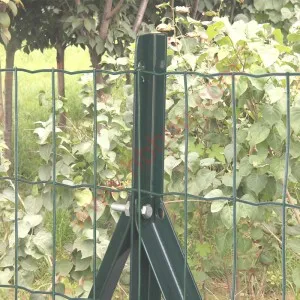The Importance of Fence Post Plates Enhancing Durability and Stability
When it comes to constructing a sturdy and reliable fence, one often overlooked component is the fence post plate. These metal plates are crucial for ensuring the longevity and stability of fences, making them an integral part of any fencing project. In this article, we’ll explore what fence post plates are, their benefits, types, and installation, as well as their impact on the overall performance of a fencing system.
What are Fence Post Plates?
Fence post plates are typically made of steel or other corrosion-resistant metals and are designed to be mounted on the bottom of fence posts. These plates create a solid foundation by elevating the posts above ground level, helping to prevent rot caused by moisture and soil contact. The plates can either be designed to be flush with the ground or raised, depending on the aesthetic preferences and functional needs of the fence in question.
Benefits of Fence Post Plates
1. Protection Against Moisture One of the primary benefits of using fence post plates is the protection they provide against moisture and ground rot. When wooden posts are in contact with the soil, they are susceptible to decay. By using a plate, the post remains elevated, significantly reducing the risk of rot and extending the lifespan of the fence.
2. Enhanced Stability Fence post plates provide additional stability to the structure. They distribute the weight and forces exerted on the fence more evenly, which is particularly important in areas with high winds or heavy snow. A well-stabilized fence will withstand these conditions better, reducing the need for repairs or replacements.
3. Ease of Installation Utilizing fence post plates can simplify the installation process. Many plates come with pre-drilled holes that allow for quick and secure attachment to wooden or metal posts. This can save time and effort during installation, making the fencing project less daunting.
4. Versatile Applications Fence post plates can be used in a variety of applications, from residential yards to commercial properties. Whether you are building a decorative picket fence or a sturdy security fence, post plates can enhance the overall design and functionality.
5. Aesthetic Appeal While functionality is key, aesthetics also matter. Metal post plates can come in various finishes and designs, allowing homeowners to choose options that complement their fencing style. This means you can have a durable fence without compromising on visual appeal.
Types of Fence Post Plates
There are several types of fence post plates available in the market, allowing you to select the best option for your specific needs
fence post plates

- Fixed Plates These are bolted directly to the post and anchored to the ground. They provide excellent stability and are commonly used in heavier-duty fencing applications.
- Adjustable Plates These plates allow for minor height adjustments after installation, making them ideal for uneven ground or adapting to changing soil conditions over time.
- Decorative Plates These plates are designed not just for functionality, but also for enhancing the aesthetic value of a fence. They come in various styles, allowing homeowners to choose based on their design preferences.
Installation of Fence Post Plates
Installing fence post plates requires some basic tools, including a drill, screws, and concrete mix if you are setting the posts in the ground. The general installation steps are as follows
1. Mark the Post Locations Determine where you want your fence posts to go by marking their locations on the ground.
2. Prepare the Ground Dig holes for the fence posts, ensuring they are deep enough to provide stability.
3. Attach the Plates to the Posts Secure the metal plates to the bottom of each fence post using screws, ensuring they are aligned properly.
4. Insert the Posts Place the posts into the prepared holes, making sure the plates are level with the ground or at the desired height.
5. Fill with Concrete If required, pour concrete around the posts to secure them in place, allowing it to cure as per the manufacturer’s instructions.
Conclusion
In summary, fence post plates are a vital component of fence construction that should not be underestimated. Their contributions to moisture protection, stability, ease of installation, versatility, and aesthetics make them an essential addition to any fencing project. Whether you are a homeowner embarking on a DIY fencing venture or a professional contractor, integrating fence post plates into your designs will ensure a durable and long-lasting solution for your fencing needs. Investing in quality post plates may require a small initial expense, but the benefits they provide in terms of longevity and reduced maintenance are invaluable.
















